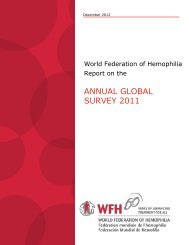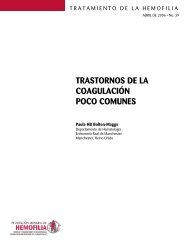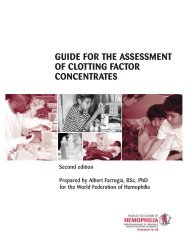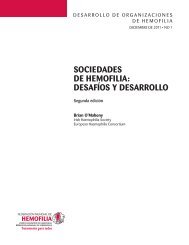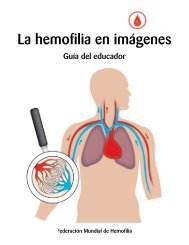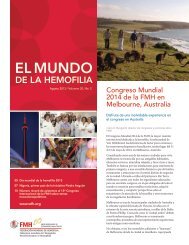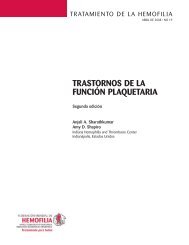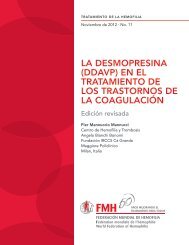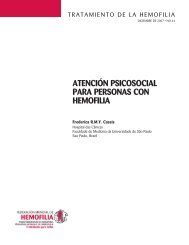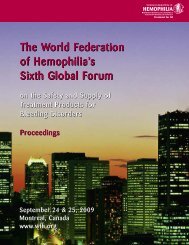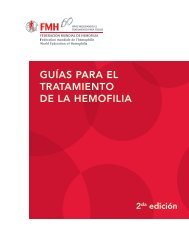Guidelines for Dental Treatment of Patients with Inherited Bleeding ...
Guidelines for Dental Treatment of Patients with Inherited Bleeding ...
Guidelines for Dental Treatment of Patients with Inherited Bleeding ...
Create successful ePaper yourself
Turn your PDF publications into a flip-book with our unique Google optimized e-Paper software.
<strong>Guidelines</strong> <strong>for</strong> <strong>Dental</strong> <strong>Treatment</strong> <strong>of</strong> <strong>Patients</strong> <strong>with</strong> <strong>Inherited</strong> <strong>Bleeding</strong> Disorders 3• The consumption <strong>of</strong> foods and drinks <strong>with</strong> ahigh sugar or acid content should be limitedto mealtimes. Three exposures per day is therecommended maximum. The aim is toensure that the intake <strong>of</strong> food and drinkdoes not cause the pH <strong>of</strong> the oral cavity t<strong>of</strong>all below the critical level <strong>of</strong> pH 5.5.• Artificial sweeteners can be used as analternative to sugars in food and drinks.Examples are aspartame, sorbitol,acesulfamate, etc.• Regular dental visits, usually every 6months, will help identify problems early,rein<strong>for</strong>ce prevention, and emphasize theimportance <strong>of</strong> reducing the intake <strong>of</strong> foodand drink containing high levels <strong>of</strong> sugar oracid.The Scottish Intercollegiate Guideline Networkhas published Preventing <strong>Dental</strong> Caries inChildren at High Risk, which includes a quickreference guide, may also be a useful resource[23]. It is available from their website athttp://www.sign.ac.uk/pdf/sign47.pdf.<strong>Dental</strong> treatmentIt is essential to prevent accidental damage to theoral mucosa when carrying out any procedure inthe mouth. Injury can be avoided by:Careful use <strong>of</strong> saliva ejectors;Careful removal <strong>of</strong> impressions;Care in the placement <strong>of</strong> X-ray films,particularly in the sublingual region;Protection <strong>of</strong> s<strong>of</strong>t tissues during restorativetreatment by using a rubber dam or applyingyellow s<strong>of</strong>t paraffin (vaseline ® ).blood loss. In addition, chlorhexidine gluconatemouthwash can be used to control periodontalproblems. Antibiotics may be required to helpreduce the initial inflammation.Blood loss <strong>of</strong> all kinds can be controlled locally<strong>with</strong> direct pressure or periodontal dressings<strong>with</strong> or <strong>with</strong>out topical antifibrinolytic agents.Periodontal surgery in patients <strong>with</strong> bleedingdisorders must always be regarded as a highriskprocedure <strong>with</strong> a significant risk <strong>of</strong> bloodloss. It should only be considered wereconservative treatment has failed and oralhygiene is good. Periodontal surgery can be agreater challenge to hemostasis than a simpleextraction. The procedure must be carefullyplanned and the risks fully explained to thepatient.Removable prosthodontics<strong>Patients</strong> <strong>with</strong> bleeding disorders can be givendentures as long as they are com<strong>for</strong>table. If apartial denture is provided it is important thatthe periodontal health <strong>of</strong> the remaining teeth ismaintained.Orthodontic treatmentFixed and removable orthodontic appliancesmay be used along <strong>with</strong> regular preventiveadvice and hygiene therapy. Special care shouldbe taken when treating patients <strong>with</strong> a severebleeding disorder to ensure that the gingiva isnot damaged when fitting the appliance.Periodontal treatmentHealthy periodontal tissue is essential to preventbleeding and tooth loss. If oral hygiene is poortreatment must start as soon as possible after thepatient has had a dental examination andtreatment plan <strong>for</strong>mulated to prevent additionaldamage to the periodontal tissues. In cases <strong>of</strong>severe periodontal disease, it may be necessaryto carry out supragingival scaling initially along<strong>with</strong> oral hygiene education. Subgingival scalingcan start as soon as the inflammation hasdecreased. The treatment may need to be carriedout over several visits to prevent excessiveRestorative proceduresRestorative treatment can be undertakenroutinely providing care is taken to protect themucosa. There is a risk <strong>of</strong> bleeding <strong>with</strong> the use<strong>of</strong> matrix bands or wooden wedges. This can becontrolled by local means or the application <strong>of</strong>topical agents. The risks <strong>of</strong> using localanesthetics and the requirement <strong>for</strong> prophylaxisare discussed in a later section.



